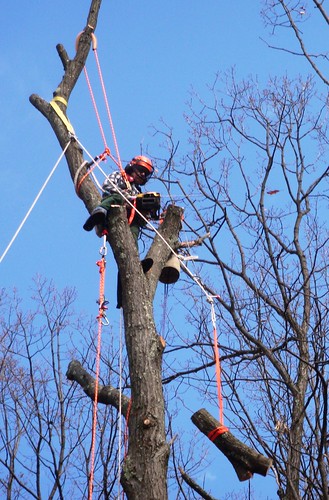I usually anchor my speedline (zipline) to the base of another tree using a whoopie sling and a port-a-wrap. I'll use another line with a 3:1 haul system to tension the speedline via a rope grab or prussik. Once the speedline line is tensioned, you can lock it off using the port-a-wrap (or fig. 8 descender) and then undo (loosen) the haul system. I find that with this system, you can quickly loosen the speedline and advance it up to another location in the tree.
Because of the side loads that you will be subjecting the tree (or branch) to, you do not want to add too much tension to the speedline. Usually I'll only have one person tension the 3:1 haul system when using pulleys, two if I'm only using carabineers in my z-haul system. However that is only a general rule. Many factors come into play. Angle of the line, length of the line and the strength of the tree are few of the considerations you have to take into account when tensioning the speedline. These side loads are greatly increased once the speedline is loaded by the branch, limb, chunk of spar, etc. More so once the item is in the middle of the speedline. Add a big bounce and the results could be catastrophic.
Usually I will set up my speedline so that the items being lowered strike the ground before the anchor, to slow them down. This can usually be accomplished by using pulleys (redirects) close to the ground on another tree. Care must be taken in setting up the system so that you do not compound the forces on your redirect anchors.
I have also used a lowering line in the tree, rigged to a small port-a-wrap, and then attached to a large item to be lowered to control the speed of descent.
NEVER drop the top or a chunk of the spar onto a speedline alone. Drop the chunk onto a false crotch/port-a-wrap system, then connect it to the speedline. Control the descent with port-a-wrap.
There is some setup time, extra equipment involved and alot of considerations to take into account, but speedlines are time saving procedures that is nice to have in your arsenal. They can reduce the effort and distance limbs must be dragged to get to the chipper (especially when the dragging is uphill) and speed up the removal over target areas.
As with any technique, and speedlines are more advanced, you are best to learn from someone with experience (take a course). Start slow, with a simple system, small pieces on a very stable (strong) tree before working your way to trickier situations.
Fast way of lowering limbs on conifers. (Just don't hit your slings with the chainswaw

)

























































